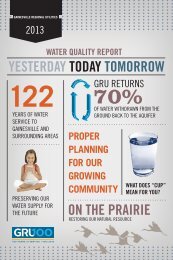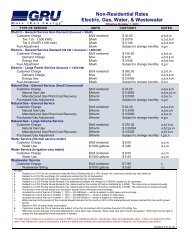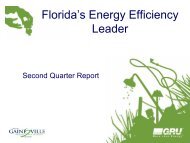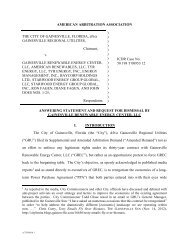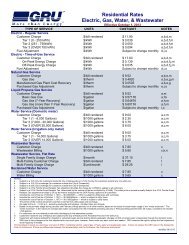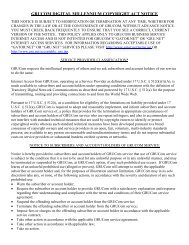Table 26. Operating output impacts for 20 MW plants, by industry.IndustryALACHUACOUNTYDUVALCOUNTYLEONCOUNTY11 Ag, Forestry, Fish & Hunting 4,328,093 3,275,310 5,185,71621 Mining 10,765 14,018 71422 <strong>Utilities</strong> 195,993 253,666 161,22523 Construction 357,048 646,204 183,40931-33 Manufacturing 112,306 327,686 50,98342 Wholesale Trade 341,895 404,788 268,17144-45 Retail trade 627,705 632,857 552,82248-49 Transportation &112,080 220,853 101,704Warehousing51 Information 222,049 240,179 258,02552 Finance & insurance 613,829 738,173 680,01353 Real estate & rental 452,051 509,021 410,60454 Professional- scientific &1,696,592 1,810,684 1,722,275technical services55 Management of companies 118,548 185,184 144,54256 Administrative & waste services 372,942 467,279 332,41761 Educational svcs 41,955 58,275 30,45862 Health & social services 752,519 724,044 599,38671 Arts- entertainment & recreation 45,034 71,286 44,86572 Accomodation & food services 336,844 315,540 288,88081 Other services 301,127 310,571 233,71292 Government & non NAICs 2,296,964 1,937,506 1,818,018Grand Total 13,336,340 13,143,123 13,067,94073
3. TASK 2: SUSTAINABILITY IMPACTS FROM LAND-USE CHANGE3.1. BackgroundA significant concern is the future availability and sustainability of the woody biomassresource base. The population in Florida is expected to grow 59% by 2030. The amount ofincreased development associated with this growth will likely reduce the forestland base fromwhich thinnings and logging debris are derived. However, the trend in Florida and throughoutthe southeast is an increase in forest plantations and annual growth rates which increases biomassavailability. Increasing population and development also increases the amount of urban woodwaste available. In this analysis, we use projections of population, pulpwood stumpage prices,and forestland use change in Florida from the USDA Forest Service’s Southern Forest <strong>Resource</strong><strong>Assessment</strong> (SFRA, Wear and Greis 2002). The baseline year for the FIA data used in the reportwas 1995. This study represents the most comprehensive and detailed analysis of forest resourceuses and trends in the US South. An update document to the 2000 <strong>Assessment</strong> is Wear et al.(2007), which describes market conditions in the forest sector since 2000. Starting around thatyear, there was a dramatic decline in stumpage prices, for pulpwood specifically, due todeclining paper production capacity combined with increasing timber inventories in the South.Stumpage prices declined some 50% from their highs in the late 1990’s. Considering the resultsof this report, the findings in the 2000 <strong>Assessment</strong> are probably somewhat overestimated withrespect to the overall strength of the southern pulpwood timber market. Importantly, the reportfound that there was no indication that domestic demand for southern pulpwood, nor stumpageprices for pulpwood, were expected to increase significantly in the near term.3.2. ScenariosThe 2000 <strong>Assessment</strong> makes projections to 2040 of total timberland, timberland by managementtype, timber removals for softwoods and hardwoods, and stumpage prices in each of the southernstates to 2040. Stumpage price changes are in real (excluding inflation) terms. The 2000<strong>Assessment</strong> includes a base case scenario and what we will call a conservative scenario. Thebase case scenario projects more land being converted to pine plantations74
- Page 3 and 4:
ACKNOWLEDGEMENTSThe authors acknowl
- Page 5 and 6:
4.2. Scenario A: Delivered to remot
- Page 7:
Figure 22. Projected softwood and h
- Page 10 and 11:
LIST OF ACRONYMS AND ABBREVIATIONSB
- Page 12 and 13:
1. INTRODUCTION1.1. Project Backgro
- Page 14 and 15:
Task-3: Transportation. Transportat
- Page 16 and 17:
2. TASK 1: WOODSHED DELINEATION AND
- Page 18 and 19:
calculations for urban wood waste a
- Page 20 and 21:
the current pulpwood harvests are a
- Page 22 and 23:
2,0001,800Acres (thousands)1,6001,4
- Page 24 and 25:
ton -1 ($17.38 green ton -1 ) for t
- Page 26 and 27: $ per million BTU, delivered$4.00$3
- Page 28 and 29: 10.65 TBtu/year required to meet de
- Page 30 and 31: haul time category in each county,
- Page 32 and 33: Figure 9. TAL Hopkins two-hour one-
- Page 34 and 35: Figure 11. GRU, JEA, and TAL woodsh
- Page 36 and 37: Dry tonsrecoverableTBtu/yearRecover
- Page 38 and 39: Dry tonsrecoverableTBtu/yearrecover
- Page 40 and 41: Table 6. Results for scenario #3,
- Page 42 and 43: Table 7. Results for scenario #4,
- Page 44 and 45: Table 9. Results for scenario #6,
- Page 46 and 47: 6.005.004.00$/MMBtu3.002.001.001: W
- Page 48 and 49: Resource/haul time categoryDry tons
- Page 50 and 51: Resource/haul time categoryDry tons
- Page 52 and 53: Table 12. Results for scenario #3,
- Page 54 and 55: Table 13. Results for scenario #4,
- Page 56 and 57: Table 15. Results for scenario #6,
- Page 58 and 59: 6.005.004.00$/MMBtu3.002.001.001: W
- Page 60 and 61: Resource/haul time categoryDry tons
- Page 62 and 63: Resource/haul time categoryDry tons
- Page 64 and 65: Table 18. Results for scenario #3,
- Page 66: Table 19. Results for scenario #4,
- Page 69 and 70: Resource/haul time categoryDry tons
- Page 71 and 72: 2.4.4. General resultsIt is difficu
- Page 73 and 74: Table 22. Yield, acreage required,
- Page 75: Table 25. Capital construction outp
- Page 79 and 80: under this scenario are expected to
- Page 81 and 82: acres in 1995 to 8.5 MM acres in 20
- Page 83 and 84: 3.3. RESULTS3.3.1. GRUTable 27. Res
- Page 85 and 86: 5.004.504.003.50$/MMBtu3.002.502.00
- Page 87 and 88: Table 30. Results for the conservat
- Page 89 and 90: 3.3.3. TAL Hopkins facilityTable 31
- Page 91 and 92: 5.004.504.003.50$/MMBtu3.002.502.00
- Page 93 and 94: For GRU most of these do not apply;
- Page 95 and 96: Table 33. Concentration yard costs.
- Page 97 and 98: location of the rail siding and the
- Page 99 and 100: discussed, to get an idea of the pr
- Page 101 and 102: 5. TASK 4: CO 2 EMISSIONS FROM HARV
- Page 103 and 104: in fuel chips and the carbon in fue
- Page 105 and 106: transporting coal. However, because
- Page 107 and 108: 6. COMBINED RESOURCE AVAILABILITYPa
- Page 109 and 110: Resource/haul time categoryTBtu/yea
- Page 111 and 112: Table 39. Combined resources (resou
- Page 113 and 114: Resource/haul time categoryTBtu/yea
- Page 115 and 116: Resource/haul time categoryTBtu/yea
- Page 117 and 118: Resource/haul time categoryTBtu/yea
- Page 119 and 120: OverstockedNatural Stands,0.16, 1%
- Page 121 and 122: logging residues from 90% to 60% to
- Page 123 and 124: ecommend that GRU, in coordination
- Page 125: 9. REFERENCESBlack and Veach (2004)



